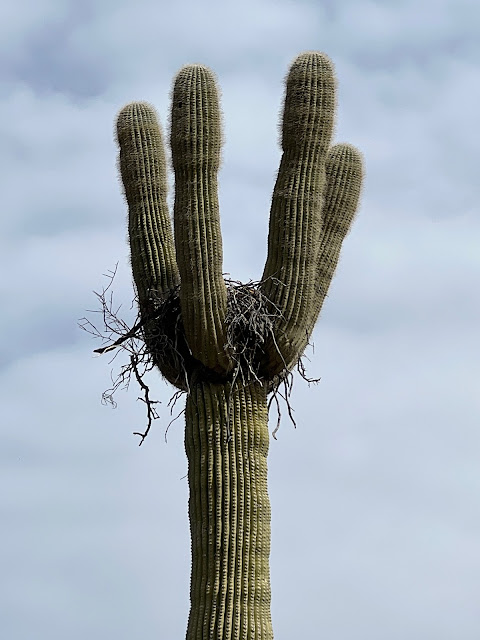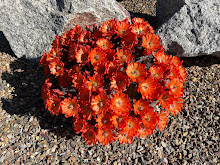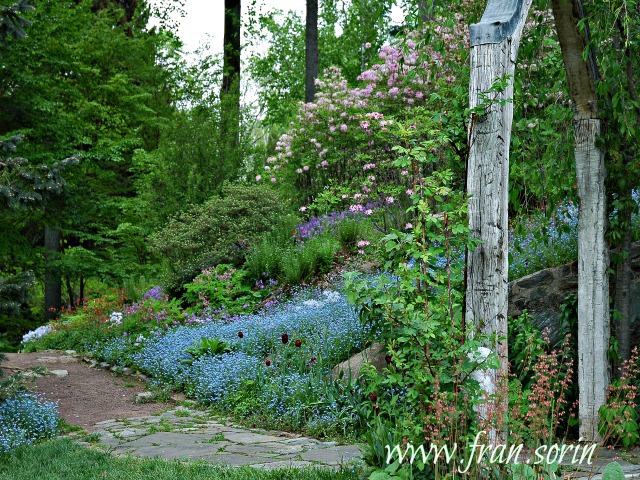The heat of summer was finally over. The garden breathed a sigh of relief. Shade cloths, which had protected some plants from the intense summer sun, were finally removed. A storm was brewing with dark thunderclouds to the west. If I had happened to look at the radar I would have seen an ugly purple patch right in the center. It was about to hit us.
Saturday, December 13, 2025
A POX ON HAIL
Monday, September 29, 2025
WHAT’S NEW IN THE GARDEN.
What's been going on in the garden. That is what I was thinking when we returned from another 3 week trip. My eyes eagerly scanned the front bed as we pulled up the driveway. It looked as though monsoon rains had been kind. The damianita, Blackfoot daisy and skullcaps were flowering. And no damage from javelina due to having left the dog fencing across the driveway. ( No letter from the HOA as yet)
One thing I try to do is to remove the fruits before they fall to the ground where they germinate. This year there are so many I will have to do a little weeding. I am now familiar with the first leaves which are nothing like the secondary leaves.
Along the side of the house the smaller leaved olive, Cordia parvifolia. The cordia are the desert blooms of the monsoon season.
The first planted pomegranate tree has, this year, 6 pomegranates, the largest of which I have protected inside a bag. The others are quite small. As yet they are unblemished and I have no idea if they are ripe. I remember the same with my fabulous pomegranate tree in Austin but it was easy to sacrifice one each week to check for ripeness, there were so many. It was usually later in the year.
And the bougainvillea just coming into flower after the rain and moderation in temperature.
So far so good. Then I noticed my prize prickly pear cactus had the starts of a cochineal infestation. From just a couple of pads this had grown quickly.
The back and sides of the house receive more visits from desert wildlife and they had been busy. One small agave eaten down to a nub. A spineless prickly pear just about annihilated. The pereskia had lost its drip line along with all its leaves. I'm not sure it will make a comeback. Death by rat and drought.
There were holes dug in the ground-the grub hunters were on the prowl. My neighbor has raccoons playing on her roof at night and using a corner of the roof as a toilet. They have professionals trying to trap them. Their wildlife camera spotted a skunk passing through last night. Another grub hunter. Was it the skunk that had ripped out two plants in order to root for grubs? But the worst of all happened last night when leaf cutter ants removed every single leaf from a Tecoma plant. It appears as though they had more cutters than gatherers and choppers, with hundreds of cut leaves beneath the plant and chopped pieces left along the pathway. This all done under cover of darkness. I could follow the trail of the few stragglers heading for home. It crossed my garden and up the wall into next door's garden. From there they crossed and climbed up and over the back wall of the property and down into the desert where the vegetation is too thick to track them to their nest. It is the most devastating thing to have happened yet and it makes me feel the closest I have ever felt to giving up gardening. "Get over it" say Tucson gardeners, who have had similar visits and hope the plant makes a recovery. We are due to leave again next week for the last camping trip of the year so I imagine in a month's time I will be doing the same inspection.
Saturday, August 23, 2025
THE SHROUDED GARDEN
It's summer in the desert and that means intense heat and little in the way of gardening. Each morning, and I am usually up by 5:30am, I open the patio doors and step outside to sample the temperature. On a good morning the temperature will be around the 70 degree mark. Maybe a little lower and there will be a slight breeze. I must make the choice between going for a walk and doing some gardening. All must be done by 9am.We make the most of these early morning hours.
No-one would doubt that this part of the Sonoran desert is not a beautiful place but if you were to look around and assess which plants are native and do well here without irrigation you would find a limited palate. Plenty of small trees, all with their small leaves ideally suited to desert heat, and they do put on a magnificent show in the spring, and a number of cactus including the saguaro, lots of fishhook barrel cactus, a sprinkling of echinocereus and small mammillaria, a few yuccas prickly pear, ocotillo and the very successful cholla. The mammillaria are quick to respond to a little sprinkle and lowering of temperatures.
But few of the cactus you may come across at the local cactus nursery will you seen the wild desert landscape. And we certainly have plenty of the finest in the country. When I visit Bach's cactus nursery I ask them which cactus can survive everything that the desert has to throw at it. They show me a small table of plants both summer and winter hardy. That said there are some additional plants that do well here and add some variety to the home landscape particularly as many have a drip irrigation system. I can't say that I have ever seen this bunny ear cactus, Opuntia microdasys, growing wild ( native to Northern Mexico) but it is beyond happy in the summer garden. Nor is it eaten by critters. It is best suited to an outdoor planting where the gardener can keep well away from it. I once walked out of my old greenhouse with a pot of this plant and the door swung to and the cactus promptly hit me in the face leaving behind thousands of tiny glochids.
This euphorbia, Moroccan mound, Euphorbia resinefera, is also a success story. Slow growing but also unlikely to be eaten by critters. Not always easy to find at a reasonable price because it takes so long to grow to a decent size.
One trick that the growers do is to put three smaller ones in a larger pot. When you come to plant they simply fall apart. The best way to overcome that is to dig the hole, cut the bottom out of the pot, slip the plant in and cut away the rest of the pot. You need a strong utility knife to cut through the plastic but this is the way I have seen the landscapers plant their big pots and cactus in particular.
When I began writing this in late June I had no idea if we would ever get away this summer. We did, making the journey up to the Wood River valley in Idaho where we were able to spend 4 lovely weeks on our favorite campsite.
But I dreaded what I would find when I got home. The hoped-for monsoon rains had been sparse and never in our area and they are so desperately needed-especially after the dry winter. I scouted the vegetation as we approached home and noticed the ocotillo were in full leaf. That was a good sign as ocotillo will drop their leaves in drought and as soon as it rains they will leaf out again, doing this multiple times in a year. There had been rain at our house because I could see flowers on the Texas sage had bloomed and withered. Those plants that had made it through dry June and July were springing back to life. I had lost several plants in pots........some had been eaten. There were plenty of holes at the base of plants where small desert critters had sought coolness. And now another rain this week has really brightened up the desert with trees and bushes coming to life.
barrel cactus are bloomingEverything has taken a big drink. Will it be enough to see the desert through the rest of the summer remains to be seen. And there is still a lot of summer left.
Sunday, June 8, 2025
THE WEIRDLY, WONDERFUL SAGUARO
The saguaros ( pronounced sa-war-o) are in bloom and they look fabulous. With their white-flowered bouquets held mainly on the crown they look positively bridal. How fortunate we are to look out every day at our Belle, who never fails to disappoint us through the month of April, May and into June.
This spring we have eagerly watched her from the very first time we took out the binoculars looking for those tell-tale little pips to appear. You can barely make out the tiny protuberances close to the crown, but as the days go by and they start to swell you know the saguaro is going to bloom.
We were concerned she might take a year off from blooming because she is not looking her best this year because of the drought. 3 years ago she was looking quite plump having filled with water during a decent rainy winter.
The monsoon last year did not deliver and we have had no rain this winter. Barely half an inch since November. Saguaros are perfectly adapted to drought and immediately there is any rain falls on the ground they quickly send out tiny roots close to the surface to take up the moisture. They fill up their stems and the pleats expand to full size. I remarked recently how wavy and thin many the saguaros were looking so it will be interesting to see the change when and if we get rain.
And yet they have bloomed heavily this year. Is this a stress bloom?
Saguaro, Carnegiea ( Cereus) gigantia, along with prickly pear are known as arboreal cactus, meaning they are tree-like with a center supporting structure similar to a tree. It is rare to find an old one standing with such a well defined skeleton. This one is on an old, abandoned nearby golf course.
They are usually found more like this.
A close up of the skeleton shows the trunk as being made up of a series of woody ribs.
The saguaro are primarily native to the Sonoran desert, the upper edges of the Colorado desert and a small area of California near to the Colorado river, growing between 600' and 3,600' It is an extremely important plant in the Sonoran desert ecology. Its fruits have been gathered by indigenous peoples to make conserves and drinks. The seeds, high in fat used as food and more recently used as chicken feed. The ribs of the plant are used for building materials and as a tool for collecting the fruits.
The saguaro is also important to many species of birds and bats who feed on the nectar within the flower. The distribution of white winged dove and the elf owl almost completely mirrors that of the distribution of saguaro. The fruits, when the pods split open are a major food source of desert birds. Woodpeckers make holes in trunks which provides a nesting are for many birds. Even branches of the saguaro make a good nesting site for larger birds.
But it is the woodpecker holes that are responsible for the rather curious structure known in the desert as the 'boot'. Often seen on display at nature centers or in the visitor center at the Saguaro National Park and Sabino Canyon. When woodpeckers carve out their hole the tree protects itself by producing a rough bark-like material, completely walling off the intrusion. Following the death of the saguaro, after it has fallen to the ground and much of its substance decayed the boot will remain. We have been fortunate to find two of these among fallen saguaros. Once dried they make a curious artifact that maybe only a desert dweller will prize. A good intact boot might have been used by indigenous peoples as a water carrier or holder.
A saguaro does not grow arms until it is at least 50+ years old. Many saguaros take on the regular candelabra shape but sometimes there is no rhyme nor reason to where the branches appear. Some are spectacularly wild in appearance.
and then there are some spectacular cristate forms where the arm creates pleats on the end of the tip which grow upwards instead of in a cylindrical manner. No-one knows why this happens. It appears to be neither causes by virus or damage to the growth point. It is probably genetic.
Estimates show that 1 in every 100,000-200,000 will cristate. Where we live in Stone Canyon, in an area of 1400 acres with an estimated 14,000-25,000 saguaros, there are 22 crested saguaros. An extremely high ratio. Someone in our neighborhood has donned his snake boots and combed the area to record all the crested saguaros. He led us on a hike one day to share a few of his findings. We also like to leave the trail and follow up one of the many washes in search of the crested form.
Now into June the height of flowering season is over. The fruits begin to swell and will provide the bird life with food through the hottest part of the summer.
On the golf course while saguaro may benefit from some additional water they are also at the mercy of the errant golf ball.
Global warming is causing the death of thousands of saguaros. The saguaro closes its pores during the day and opens them up at night for photosynthesis. Overly high nighttime temperatures, this last two summers have meant their pores have failed to open. They have had to rely on stored water with the resulting loss of integrity of the stem. They will often drop and arm in the same way that trees will drop leaves in order to survive. We have been a little more fortunate that the desert floor because we are at 3000' and about 8 degrees cooler than Phoenix but even here the changing weather conditions have taken their toll on the saguaro count. Plus in order for saguaros to germinate and survive they need at least 3 good wet seasons. We are all hoping for a really good monsoon this year although the predicted extreme highs in the coming weeks have us all a little worried.


















































.jpeg)
.jpeg)





























